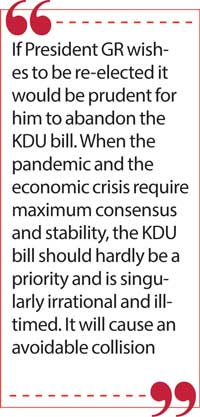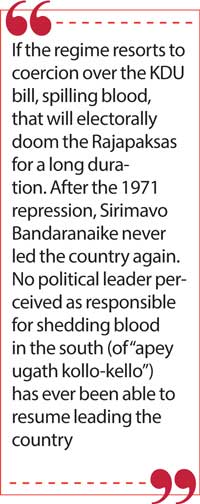Saturday Nov 29, 2025
Saturday Nov 29, 2025
Thursday, 22 July 2021 00:00 - - {{hitsCtrl.values.hits}}

Any violent suppression of the movement against the KDU bill will drastically damage the political futures of Basil Rajapaksa and Namal Rajapaksa. They must remember the maestro Mahinda Rajapaksa, who learned it, in part, by observing Prime Minister Premadasa: never whitewash the unpopular measures of your Government or be its hit-man; instead, signal your dissent publicly
 It probably wasn’t a mere slip of the tongue that made President Gotabaya Rajapaksa declare: “Not only three more years. I have five additional five years” (The Island). He should have said “if I win a second term”. What makes him regardan additional five years apart from the remaining three of his current term of office, as automatic and axiomatic? Later in this column I argue that the KDU bill furnishes clues.
It probably wasn’t a mere slip of the tongue that made President Gotabaya Rajapaksa declare: “Not only three more years. I have five additional five years” (The Island). He should have said “if I win a second term”. What makes him regardan additional five years apart from the remaining three of his current term of office, as automatic and axiomatic? Later in this column I argue that the KDU bill furnishes clues.
The President’s unambiguous declaration of intent to continue for the next eight years slaps down the hopes animating the Basil Rajapaksa surge. BR fans (e.g., Prof. Ranjith Bandara) were seen on TV news and FB confidently asserting he would be the candidate in 2024. As the crisis mounts, the candidacy issue will re-emerge.
No Confidence Motion
JVP Leader Anura Kumara Dissanayake’s crude remarks in Parliament about the “political stupidity” of the SJB’s censure motion are a classic example of sectarianism and immaturity. A leader on whose watch the JVP’s parliamentary strength dropped from 40 to three seats (and 3%) in 15 years is hardly an authority on political wisdom, nor in a position to lecture the one-year-old SJB which on its first electoral outing, beat the initial performance (1952) of SWRD’s SLFP, in terms of seats and percentages and established itself as the island’s main Opposition party, a status the JVP has vainly aspired to for decades.
Worse still, AKD obviously hasn’t grasped Che Guevara’s point in his last political essay, ‘Message to the Tricontinental’ about “battles won or lost—but fought—against the enemy”. The SJB’s censure motion was just that.
Worst of all, AKD’s intemperate remarks displayed just the kind of sectarianism that is utterly counterproductive on the eve of a historic battle against the KDU bill, which requires all the allies it can get to lean into the struggle and provide covering fire in Parliament. This especially means the main Opposition party. AKD’s subjectivism is the resurgence of a factor that tripped up the JVP so many times in its history. The record shows the only thing it has ever beaten and surpassed politically is Ranil Wickremesinghe’s dying UNP.
Dullas Alahapperuma pointed out in the debate that in 1972 Ranasinghe Premadasa as an Opposition MP moved a censure motion against the United Front coalition government, which was defeated by a two-thirds majority. He correctly predicted the same fate for Sajith Premadasa’s NCM, but failed to say how that 1972 story ended. At the very first General Election, the coalition government with a two-thirds majority was swept out by the Opposition (of which Premadasa was Deputy Leader) which won a five-sixths majority.
Global alert
Amnesty International (AI), the world’s oldest, most respected human rights organisation sent out an Urgent Action Appeal last week informing that Hejaaz Hezbullah had been designated an AI Prisoner of Conscience and calling for a global campaign for his release. A Prisoner of Conscience is a very special category. Throughout its long history, AI designates someone a Prisoner of Conscience only after thorough verification that he/she has not been involved in violence or its advocacy.
Of course, this Government can adopt the same dismissive hostility towards Amnesty International that Justice Minister Felix Dias Bandaranaike did towards AI’s Lord Avebury in the early 1970s. Time was much kinder to AI than to the once-feared FDB.
 The Economist
The Economist
There was once a photograph of a US President strolling across the White House lawn with a folded copy of The Economist (London) sticking out of his back pocket. I think it was Bush Sr., but it could have been Clinton. The photograph was evidence that the status of the Economist had not changed from the 19th century observation by Karl Marx who called it “the most intelligent defender of capitalism”.
It is safe to say that every leader in the world reads The Economist. The Banyan column in the Asia section of the latest issue of The Economist is devoted to Sri Lanka. The title is ‘Rajapaksa Raj’ and the strap tells the story: “Sri Lanka’s Rajapaksa dynasty is not as secure as it appears”. It clarifies: “The family that runs everything is running out of cash.”
Every world leader, Cabinet Minister and top official who reads The Economist will see these analytical conclusions, among others:
“Since winning the presidency in a landslide nearly two years ago, Gotabaya Rajapaksa has worried not that he has too many relatives in Government, but that he has too few. One of the 72-year-old’s elder brothers, Mahinda, himself president for 10 years until a surprise election defeat in 2015, is prime minister. Another, Chamal, is minister for irrigation. Chamal’s son, Shasheendra, is minister of state for ‘paddy and grains, organic food, vegetables, fruits, chillies, onions and potatoes, seed production and high-tech agriculture’. Mahinda’s son, Namal, is minister for youth and sports. And state minister for digital technology and enterprise development. And everything else, to judge by his hyperactive Twitter feed.
“But there is always room for one more Rajapaksa, 69-year-old Basil above all…
“…But there are complications. One has to do with Mahinda... Basil is his obvious replacement as prime minister. Yet it is from Mahinda’s folksy charisma that the family’s aura derives. When he goes, so does a big part of the Rajapaksa appeal.
“The obvious family response would be to tighten its hold on power yet further. The tendencies are there. Gota, who as defence secretary prosecuted the end of Sri Lanka’s brutal civil war in 2009, retains the defence and intelligence portfolios. By temperament a martinet, he has stuffed his administration with ex- and current brass…
“The complication here is getting Sri Lankans to play along. These days, Gota’s irascibility inspires more scorn than fear. Farmers decry Gota’s ill-considered push for organic farming free of imported fertiliser. Others call for justice for the civil war’s victims. Activists who recently took to the streets against the expansion of a military-backed university that is exempt from national oversight were bundled away for supposedly breaking coronavirus restrictions and given 14 days’ enforced quarantine. In response, the country’s teachers have gone on strike. Even SLPP members grumble that the Rajapaksa tribe is taking too much power, leaving too little for the hangers-on. Sri Lankans have a history of hoofing overweening governments out. That makes the Rajapaksas’ suffocating hold on power look like a weakness.” (https://www.economist.com/asia/2021/07/15/sri-lankas-rajapaksa-dynasty-is-not-as-secure-as-it-appears)
KDU collision
If President GR wishes to be re-elected it would be prudent for him to abandon the KDU bill. When the pandemic and the economic crisis require maximum consensus and stability, the KDU bill should hardly be a priority and is singularly irrational and ill-timed. It will cause an avoidable collision.
The degree of kinetic power needed to be deployed by the Government to disintegrate the protest movement will lead to polarisation and radicalisation, making any ‘victory’ on the part of the regime a Pyrrhic one. An open-ended postponement of the bill and a presidential convening of a roundtable of all stakeholders—student unions, academics, teachers and professionals—to negotiate a consensual solution, would make good strategic sense. But I’m not optimistic.
President Gotabaya said (as seen on TV news) that “the UGC (University Grants Commission) Act is being reviewed for amendment”. As the Federation of University Teachers Associations (FUTA) points out, there is no “UGC Act”; there is the Universities Act. The President’s point is that it is not the KDU bill that will be amended to bring it into line with the Universities Act, but that the Universities Act will be amended to accommodate the KDU bill. It is important to grasp the implications: the logic of the project of expanding and proliferating the military university, which was once a military academy will not be modified still less circumscribed to fit into the established civilian structure. To the contrary, the civilian structure will be carved open to make way for the emerging military-academic entity.
The logic of the President’s disclosure, if it is acted upon, is that henceforth, civilian norms will be subordinated to the exigencies of the new role he envisages for the military, and the new Social Contract he has been drawing up in which the military and all matters military are on top.
The cumulative critique of the resistance movement against the KDU bill is sharp, but insufficiently holistic. Dangerous as it is, the KDU bill with its project of a parallel military-dominated structure in education, is the de jure expression and extension of something that already exists, de facto. That parallel structure already lives in the State and Government; and it is not merely parallel, it is dominant.
 It’s the MCF, stupid
It’s the MCF, stupid
Throughout the State, not only where the “over two dozen” (The Hindu) ex-military brass serve, there is hardly a purely civilian authority, command-and-control structure or sphere of influence anymore. China’s Military-Civil Fusion (MCF) doctrine is being applied far beyond the limits it operates within in China. In President Gotabaya’s Sri Lanka, MCF is system-wide.
There is an interface with the military everywhere. The Sri Lankan State itself is becoming military-occupied territory; militarisation as process and militarism as ideology and ontology, are metastasising, thereby metamorphosing the Sri Lankan State itself into something else. Political science dubs this a ‘creeping coup’: a coup as process, not event.
The elected Government no longer leads and dominates the State machine. Under President GR, the State machine, which has changed character with the civilian administrators and processes being subsumed by the military, now provides the effective parameters for the elected civilian government.
Just as the LTTE helped create and dominated the Tamil National Alliance (TNA) at one time, the Government, the Cabinet and even the SLPP are today what the TNA was when Prabhakaran and the LTTE wielded power.
Sun Tzu said “know yourself, know your enemy; a thousand battles, a thousand victories”. The KDU bill is NOT the SAITM bill. The project is not identical and the drivers and backers aren’t the same. As Jeff Bridges advised Ryan Reynolds in the movie R.I.P.D, “This ain’t that”.
The KDU bill hopes to militarise the nation’s ethos while creating wave upon wave of hybrid ‘Military-Civilian Fusion’ graduates who may be privileged in future employment and could replace the existing civil servants. The bill will create pedagogical pods which are nurseries of a new ruling class; a new power-elite.
This project is the outgrowth, an extension of a transformation that has taken place and is taking place in the state. The KDU bill involves, and is the symptom of, the hopes, aspirations and plans of this country’s real power cartel/network under the Gotabaya presidency.
The opponent
When the protest movement goes up against the KDU bill, it must know who will be on the other side, what their mentality is and to what lengths they may go. We are not talking simply about the Government – which is only a front—or the Police, which is only the instrument of first resort. The STF and military are being kept in reserve. This regime, with its low threshold of tolerance—could escalate faster than anyone thinks.
The Movement against the KDU bill will not find itself up against the Government but against the State; not as it was, but as it has become and is becoming.
It is hardly my contention that the Movement must retreat, but that the obstacles and odds are greater, and stakes even higher, than it may think.
Victory isn’t assured by the manifest justice of one’s cause, the manifest injustice of the opponent’s cause, and one’s determination to risk imprisonment or sacrifice life and limb for one’s just cause. It requires clarity of analysis, comprehension of the target and the balance of forces, strategy, tactics, organisation in depth, broad alliances, mobility and manoeuvre, and marshalling of reserves.
The KDU project is but a subset of a much larger, deeper project of pre-emptive or preparatory Myanmarisation, with a variant being an Egyptian Al Sisi outcome. The contest is truly historic because it is objectively a struggle between that project, and those who oppose it.
Those mass-democratic political parties that require an electoral level-playing field as the only access to power, have to be drawn prominently into the bloc of resistance.
While the Ceylon Teachers’ Union and TNA MPs protested in Jaffna, the university student movement in the north and east, which perennially protests against militarisation, was conspicuously silent and absent. If it remains self-ghettoised, failing to throw its weight behind the anti-militarisation struggle of its Southern counterparts, it will never secure a supportive Southern progressive-democratic constituency for reversing militarisation.
A minority can escape marginalisation only through broad alliances with the progressive-democrats of the majority.
The flipside is no less true. The militarisation project cannot be defeated only by the student youth of the south, without northern and eastern generational allies.
The anti-KDU Movement stands in danger of peaking or being over-exposed to suppression prematurely, while the crisis over the failing harvest and urban food supply is on a slower-burning fuse. As guarantee against a repetition of the outcome of the July 1980 General Strike, the Movement requires the student-worker synergy of November 1976 with the urban-rural and South-North synergies of August 1953. That needs a greater, deeper “accumulation of social and political forces” as they say in Latin America.
Basil and Namal
If the regime resorts to coercion over the KDU bill, spilling blood, that will electorally doom the Rajapaksas for a long duration. After the 1971 repression, Sirimavo Bandaranaike never led the country again. No political leader perceived as responsible for shedding blood in the south (of “apey ugath kollo-kello”) has ever been able to resume leading the country.
Any violent suppression of the movement against the KDU bill will drastically damage the political futures of Basil Rajapaksa and Namal Rajapaksa. They must remember the maestro Mahinda Rajapaksa, who learned it, in part, by observing Prime Minister Premadasa: never whitewash the unpopular measures of your Government or be its hit-man; instead, signal your dissent publicly.
This is near-impossible for Basil, now the first mate on the Titanic. Less so for Namal. Chandrika showed it can be done. Sunethra and Chandrika were genuinely, openly and actively opposed to their mother Prime Minister Sirimavo Bandaranaike’s brutal repression of the 1971 uprising. CBK revived her early 1970s dissent when Vijaya Kumaratunga and she broke away from Madam Bandaranaike’s nationalist SLFP in Opposition and formed the left-of-centre SLMP (1984), traveling to India to meet the Tamil militant leaders (1985). She later formed the BNP (1991).
A history of progressive, populist political non-conformism enabled CBK to outflank the matriarch, overtake front-runner Anura, take over the party and lead it to victory, returning the Bandaranaikes to power for two terms after 17 years. Thus, they led the island, with intermissions, for a quarter-century.
A defining point in Chandrika’s trajectory to the top was the 1980s Monaragala peasants’ agitation. Today’s anti-KDU and the peasants struggles will yield tomorrow’s leader of the SLPP (in Opposition).